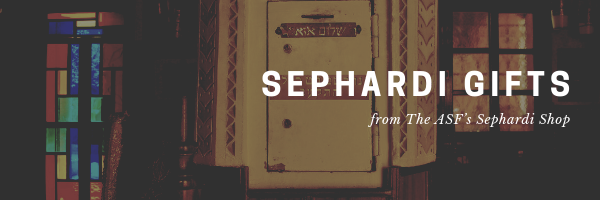In Honor of David E.R. Dangoor, President of the American Sephardi Federation
Click here to dedicate a future issue in honor or memory of a loved one
Upcoming Events ◊ ASF Sephardi Shop ◊ Donate ◊ Sephardi Ideas Monthly ◊ ASF IJE ◊ ASF Sephardi House ◊ Archive
🎩“Lincoln’s Sephardic Inspiration at Gettysburg”
(Scan courtesy of The Marvin Weiner Catalogue of the Sabato Morais Ledger (University of Pennsylvania Libraries: Schoenberg Center for Electronic Text and Image), p. 22)
Pictured above is an excerpt of Rev. Dr. Sabato Morais’s sermon on Independence Day, 4 July/17 Tammuz, 1863. An avid abolitionist and proponent of Abraham Lincoln and the Patriot’s cause in the War of the Rebellion then ragging, the sermon Morais delivered at Philadelphia’s Mikveh Israel, was republished about a week later in New York’s The Jewish Messenger. From there Morais may “have made a lasting contribution to American rhetorical history” as his then-unique phraseology would subsequently appear, whether deliberately or coincidentally is unknowable, in Lincoln’s Gettysburg Address (see: Marc Saperstein’s “‘Four Score and Seven Years Ago’: A Jewish Connection”)
The excerpt reads: “I am not indifferent, my dear friends! to the event [the Declaration of Independence] , which four score and seven years ago, brought to this new world light and joy. I yield to none in the feelings of deep reverence for the sages and patriots that labored for its consummation. The principles enunciated in the document unfolded and first read in yonder hall, command still my highest admiration. But the more intently I gaze upon the bright past, the darker does the present appear to my vision.”
Thankfully, unlike the Jewish defenders at Jerusalem in 70 CE, the Union defenders repelled their attackers, the Confederate invaders of the North, at Gettysburg on 1-3 July, as Morais found out after his sermon.
To learn more about Mikveh Israel’s Hakham Rabbi Dr. Sabato Morais see: Sephardi Ideas Monthly’s “Continuity, not Rupture: Sabato Morais’s Sephardi Rabbinic Humanism in Victorian America” and “A Dream Deferred: The Andalusian-Italian Sephardi Tradition in America.”
~~~~~~~
✡️“Inaugurating NYC’s Mill Street Synagogue/Seixas Way”
ASF President David Dangoor, Mill Street Synagogue/Sexias Way Co-Naming Ceremony, 8 April 2019
(Photo courtesy of Zak Siraj)
The first synagogue in North America was located on Mill Street in lower Manhattan. Built in 1730 to serve Congregation Shearith Israel, the Spanish & Portuguese Synagogue’s Reverend, Gershom Mendes Seixas, preached persuasively on behalf of the principles of liberty and supported the Patriot's cause in the American War of Independence.
On 8 April 2019, 289 years to the day the synagogue was built, the Lower Manhattan Historical Association, the Sons of the Revolution in the State of New York, the American Sephardi Federation, the Temple of Universal Judaism, and the Jewish Learning Experience came together with 1st District New York City Council Member Margaret Chin to inaugurate the co-naming of South William Street as the Mill Street Synagogue/Seixas Way.
Ambassador John Loeb was also honored at the ceremony with the LMHA & Sons of the Revolution in the State of New York’s Religious Freedom Award.
Click here to watch the ceremony
~~~~~~~
Feature: Emma Lazarus, Irving Berlin, and “Miss Liberty”📜🖋
Excerpt from the original The New Colossus, in Emma Lazarus’ notebook, part of the permanent collection of The American Jewish Historical Society at The Center for Jewish History
America’s willingness to open her doors to immigrants from every corner of the globe has been unique in the annals of world history. This 4th of July, the American Sephardi Federation celebrates the vision of freedom that has moved millions to immigrate to America with Irving Berlin’s musical rendition of American Sephardi poet Emma Lazarus’ “The New Colossus,” the sonnet that adorns the foot of the Statue of Liberty. Berlin’s song, “Give Me Your Tired, Your Poor,” is taken from his 1949 musical, “Miss Liberty.” In this 2009 performance, Lazarus’ famous lines are sung by Sandy Patti, together with the Cincinnati Pops.
~~~~~~~
Bonus Feature: Jewish Spain in American Tongue: The Sephardic Return of Emma Lazarus📖🖋️
(Screenshot courtesy of The Jewish Broadcasting Service)
À propos Independence Day: watch ASF Broome & Allen Fellow Leonard Stein’s fascinating Young Sephardi Scholars Series lecture at The Center for Jewish History, co-sponsored by the American Jewish Historical Society and Leo Baeck Institute, on the life and work of American Sephardi poetess and patriot Emma Lazarus, whose iconic sonnet is inscribed upon the pedestal of the Statue of Liberty.
~~~~~~~
🔔“Covenant and the American Founding”
Abolitionist William Lloyd Garrison’s banner featuring the Liberty Bell’s image and inscription (from Vayikra/Leviticus XXV:X): “Proclaim LIBERTY throughout all the Land unto all the Inhabitants thereof”
Boston, MA., 1843
(Photo courtesy of the Massachusetts Historical Society)
In 2017, Sephardi Ideas Monthly featured a series of articles on the political concept of “covenant” by Professor Daniel J. Elazar, a highly successful political theorist and the Founder and First President of both the American Sephardi Federation and Jerusalem Center for Public Affairs. In the series' third article, Professor Elazar begins with Abraham Lincoln’s “view of the American experience as being parallel to that of biblical Israel. If Americans were not the chosen people, they were at least, in his eyes, ‘an almost chosen people.’”
~~~~~~~
🕍“Star Spangled Banner-based Syrian Sephardi Piyyut ”
Hebrew Text and Recording by Sephardic Pizmonim Project
Introduction by Eddie Ashkenazie, Sephardi World Weekly
Magen David Congregation, Brooklyn, NY
(Photo courtesy of At Home Studios)
Magen David Congregation was the first Syrian Sephardi synagogue built in Brooklyn. In honor of its 1921 inauguration, Rabbi Moses Ashear, who would serve as the hazzan of the Congregation until his death, composed a piyyut. Incorporating verses and terminology from the Tanach, the song begins by praising the actions of the committee who built the synagogue and then goes on to glorify the building and its importance for the community that would grow around it.
While other songs were written for the occasion, only this piyyut was set to the Star-Spangled Banner. The reason is unknown. Perhaps Rabbi Ashear, as an immigrant to the United States from Syria in the early 1900s, wished to celebrate the community finding success in America by synthesizing an aspect of the Syrian tradition (the composition of piyyutim) with the National Anthem. He may also have wished to situate this event within the context of America’s ideas and ideals, especially our rights to Thought, Worship, Speech, and Assembly, as codified in the Declaration of Independence and Constitution.
~~~~~~~
The American Sephardi Federation invites all individuals, communities, and organizations who share our vision & principles to join us in signing the American Sephardi Leadership Statement!
Please also support the ASF with a generous, tax-deductible contribution so we can continue to cultivate and advocate, preserve and promote, as well as educate and empower!
~~~~~~~
Saving Monticello: The Levy Family’s Epic Quest to Rescue the House That Jefferson Built
By Marc Leepson
Saving Monticello offers the first complete post-Jefferson history of this American icon and reveals the amazing story of how one Sephardic Jewish family saved the house that became a family home to them for 89 years - longer than it ever was to the Jeffersons.
Commodore Uriah P. Levy discovered that Jefferson’s mansion had fallen into a miserable state of decay. Acquiring the ruined estate and committing his considerable resources to its renewal, Levy began what became a tumultuous nine-decade relationship between his family and Jefferson’s home. After passing from Levy control at the time of the commodore’s death, Monticello fell once more into hard times, cattle being housed on its first floor and grain in its once elegant upper rooms. Again, remarkably, a member of the Levy family came to the rescue. Uriah’s nephew, the aptly named Jefferson Monroe Levy, a three-term New York congressman and wealthy real estate and stock speculator, gained possession in 1879.
After Jefferson Levy poured hundreds of thousands of dollars into its repair and upkeep, his chief reward was to face a vicious national campaign, with anti-Semitic overtones, to expropriate the house and turn it over to the government. Only after the campaign had failed, with Levy declaring that he would sell Monticello only when the White House itself was offered for sale, did Levy relinquish it to the Thomas Jefferson Foundation in 1923.
Click here to read Marc Leepson's exclusive interview in Sephardi Ideas Monthly and here to learn more about the anti-Semitic campaign against the Levy family.
Remnant of Israel a Portrait of America's First Jewish Congregation
by Hakkham Rabbi Dr. Marc D. Angel
Special Edition for the American Sephardi Federation
Published to mark Shearith Israel's 350th anniversary, Remnant of Israel a Portrait of America's First Jewish Congregation tells their individual stories as well as the history of the Congregation, explaining its origins, its rituals, and its traditions. It is profusely illustrated with portraits, historical documents and ritual objects. This book tells a fascinating story, one that will appeal to anyone interested in the history and culture of the Jewish People, of New York City, and of the United States.
~~~~~~~
Upcoming Events or Opportunities
The ASF’s Institute of Jewish Experience presents:
The Aden Conference
Building on the success of the ASF and E’eleh B’Tamar’s “The Yemenite Conference: Jews and Muslims in Yemen” held in 2017 at New York’s Center for Jewish History, the Aden Conference will bring together the world’s leading scholars from Aden, Israel, US, UK, and Europe to explore the historical, cultural, and communal dynamics that intersected in Aden and its environs, particularly under British rule.
28-30 August 2023
Opening Night | JW3, London
Conference | Woolf Institute, Cambridge
Cambridge, Madingley Rd, Cambridge CB3 0UB, UK
Sign-up Now!
Co-Presenters:
Woolf Institute, ASMEA (Association for the Study of the Middle East & Africa), Aden Jewish Heritage Museum, Zalman Shazar Center, and Harif: Association of Jews from the MENA
~~~~~~~
American Sephardi Federation presents:
Convergence: Arabic, Hebrew, and Persian Calligraphy in Conversation
Featuring the multilingual art of Ruben Shimonov Convergence creates a visual world where Hebrew, Arabic, and Persian languages interact with, and speak to, one another; a world where stylized letters and words dance together on the page; a world where cultures, religions, communities, and philosophies intersect.
Juxtaposing cognates from these ancient West Asian languages, artist Ruben Shimonov encourages the viewer to explore the deep-rooted connections between these tongues, as well as the multilayered and transnational identity of the artist himself.
On View in the Leon Levy Gallery through 16 July 2023
@ the Center for Jewish History
~~~~~~~
American Sephardi Federation and Mimouna Association’s Rebuilding Our Homes Project present:
Re-Creation: Judaica by Moroccan Muslim Artisans
Explore the exhibition of Judeo-Moroccan art, Moroccan Judaica, cultural and religious objects, including Menorot, Mezuzot, Yads, Shabbat Candleholders, Seder Plates, Hallah Covers, and much more.
On View through 31 December 2023
@ the Center for Jewish History
As Moroccan Jewish populations largely left the mellahs (Jewish quarters) in the latter half of the 20th century, there was a danger that not only designs but even the traditional artisanal techniques needed to create them would be lost. Passed down from one artisan to another and perfected over time, these designs and techniques. ranging from vibrant patterns to intricate metalwork and soulful wood carvings, are expressions of Moroccanity and reflect the individual character of each city. The materials and craftsmanship of Rabat are different than Fez, and Essaouira is distinct from both.
Mimouna Association and the American Sephardi Federation’s Rebuilding Our Homes Project, a multi-year USAID-supported New Partnerships Initiative, brought three notable experts-Ms. Zhor Rehihil, Ms. Deborah Koenigsberger Gutierrez, and Ms. Meryem Ghandi to train Moroccan Muslim artisans in the history of Judeo-Moroccan art and guided them in re-creating Moroccan Judaica, which encompasses a diverse array of cultural and religious objects, including Menorot, Mezuzot, Yads, Shabbat Candleholders, Seder Plates, Hallah Covers, and much more.











